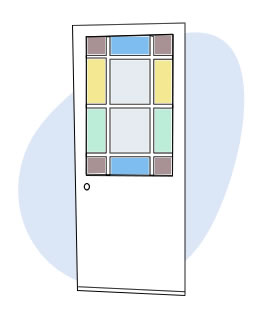
What types of doors are made with leadlight doors and stained glass?
Leadlight and stained glass doors provide a beautiful interplay of light and colour, and are typically used as front doors in homes. They catch the eye upon entry and can radiate an amazing and changing colour scheme through the hallway, depending on the angle of the light. Leadlight insets may also sometimes be used in interior doors to common rooms (such as the lounge room) in older houses.
How are leadlight doors and stained glass doors constructed?
Strips of lead, called lead came, are laid out according to the pattern for the design. Glass of various colours, thicknesses and textures is then cut to fit each piece in the frame and delicately placed in the framework. The lead came then gets pressed down to clamp the glass and soldered at key points to retain its stability. Putty mixed with a little linseed oil is pushed into all the joints afterwards and allowed to set for a day or two before being brushed with a dusting of plaster and black oxide. This is what gives the lead its aged appearance.
How do leadlight doors and stained glass doors perform?
- Security – Leadlight is quite fragile (or, at least as fragile as glass) so it can be easily broken. Like glass, this type of door is usually accompanied by some sort of security door or grille.
- Weatherproofing – Stained glass windows can hold their own against the weather, though given time the lead can begin to sag which can cause panels to crack or become loose.
- Soundproofing – Lead light features in doors do not block sound very well and can compromise a door’s natural resistance to sound by giving it a passage to work through.
- Cost – Leadlighting is expensive, but offers a unique look.
- Weight – Because of the lead content, these panels weigh more than a typical glass panel of equivalent size.
- Thermal insulation – The glass used in stained glass features is usually thin, so it doesn't provide fantastic thermal insulation - however, as it's typically limited in size, this does not cause to many issues with heating costs.



